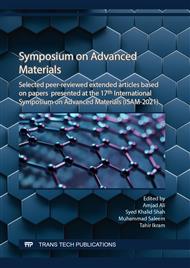[1]
N. Amin, M. Yousaf, M. Javid and A. Farooq, Comparison of Pulse Sequences of Magnetic Resonance Imaging for Optimization of Timing and Image Quality, Ira. J. Med. Phy. 17 (2020) 350-358.
Google Scholar
[2]
X. Yin et al., Large T 1 contrast enhancement using superparamagnetic nanoparticles in ultra-low field MRI, Sc. rep. 8 (2018) 1-10.
Google Scholar
[3]
C. Burtea, S. Laurent, L. Vander Elst, and R. N. Muller, Contrast agents: magnetic resonance, Molec. imag. 1 (2008)135-165.
DOI: 10.1007/978-3-540-72718-7_7
Google Scholar
[4]
N. Amin, , R. M. Afzal, M. Yousaf, and M. Javid, Comparison amongst pulse sequences for enhanced contrast to noise ratio in magnetic resonance imaging, J. Pak. Med. As. 67 (2017) 225-232.
Google Scholar
[5]
N. V. Vallabani, S. Singh, and A. S. Karakoti, Magnetic nanoparticles: current trends and future aspects in diagnostics and nanomedicine, Current drug metabolism, 20 (2019) 457-472.
DOI: 10.2174/1389200220666181122124458
Google Scholar
[6]
G. J. Strijkers, W. J. M Mulder, G. A. F van Tilborg, and K. Nicolay, MRI contrast agents: current status and future perspectives, Anti-Cancer Agents in Medicinal Chemistry (Formerly Current Medicinal Chemistry-Anti-Cancer Agents), 7 (2007) 291-305.
DOI: 10.2174/187152007780618135
Google Scholar
[7]
J. M. Arshad, W. Raza, N. Amin, K. Nadeem, M. I. Arshad, and M. A. Khan, Synthesis and characterization of cobalt ferrites as MRI contrast agent, Materials Today: Proceedings, (2020).
DOI: 10.1016/j.matpr.2020.04.746
Google Scholar
[8]
N.Amin,M. Afzal, M. Yousaf and M.A. Javid, Choice of the pulse sequence and parameters for improved signal-to-noise ratio in T1-weighted study of MRI, J. Pak. Med. Assoc. 65(2015) 512-518.
Google Scholar
[9]
W. Jiang et. al., Preparation and properties of superparamagnetic nanoparticles with narrow size distribution and biocompatible, J. Magn. and Magn. Mater. 283 (2004) 210-214.
Google Scholar
[10]
A. Akbarzadeh, M. Samiei, and S. Davaran, Magnetic nanoparticles: preparation, physical properties, and applications in biomedicine, Nano. res. lett. 7 (2012) 144.
DOI: 10.1186/1556-276x-7-144
Google Scholar
[11]
M. Scimeca, S. Bischetti, H. K. Lamsira, Energy Dispersive X-ray (EDX) microanalysis: A powerful tool in biomedical research and diagnosis. Eu. J. Histochem.62 (2018) 2841.
DOI: 10.4081/ejh.2018.2841
Google Scholar
[12]
M. J. Arshad et al., Synthesis, Characterization and Blood Based Toxic Effects of Superparamagnetic Nanoparticles, Materials Science, 25 (4) (2019) 359-364.
Google Scholar
[13]
M. Anbarasu, M. Anandan, E. Chinnasamy, V. Gopinath, and K. Balamurugan, Synthesis and characterization of polyethylene glycol (PEG) coated Fe3O4 nanoparticles by chemical co-precipitation method for biomedical applications, Spectrochimica Acta Part A: Mol. and Biomol. Spectro. 135(2015) 536-539.
DOI: 10.1016/j.saa.2014.07.059
Google Scholar
[14]
Javid M.,Sajjad M.,Ahmad S.,Khan M.,Nadeem K.,Amin N. and Mehmood Z. (2020) Synthesis, electrical and magnetic properties of polymer coated magnetic nanoparticles for application in MEMS/NEMS. Mater. Sci. Poland, Vol.38 (Issue 4), pp.553-558.
DOI: 10.2478/msp-2020-0080
Google Scholar
[15]
M.J. Arshad, A. Saddique,M. Zahid,A. Niama, H.Fayyaz,Synthesis, Characterization and Blood Based Toxic Effects of Superparamagnetic Nanoparticles, Mater. Sci. 25(4)(2019) 359-364.
DOI: 10.5755/j01.ms.25.4.21149
Google Scholar
[16]
A. Akbarzadeh, M. Samiei, and S. Davaran, Magnetic nanoparticles: preparation, physical properties, and applications in biomedicine, Nano.Res. lett. 7 (2012) 144.
DOI: 10.1186/1556-276x-7-144
Google Scholar
[17]
A. A. Hernández-Hernández, G. Aguirre-Álvarez, R. Cariño-Cortés, L. H. Mendoza-Huizar, and R. Jiménez-Alvarado, Iron oxide nanoparticles: synthesis, functionalization, and applications in diagnosis and treatment of cancer, Chem. Pap. 74 (2020) 3809-3824.
DOI: 10.1007/s11696-020-01229-8
Google Scholar
[18]
J. A. Lopez, F. González, F. A. Bonilla, G. Zambrano, and M. E. Gómez, Synthesis and characterization of Fe3O4 magnetic nanofluid, Revista Latinoamericana de Metalurgiay Materiales, 30 (1) (2010) 60-66.
Google Scholar
[19]
S. A. Kulkarni, P. Sawadh, P. K. Palei, and K. K. Kokate, Effect of synthesis route on the structural, optical and magnetic properties of Fe3O4 nanoparticles, Ceram. Int. 40 (2014) 1945-1949.
DOI: 10.1016/j.ceramint.2013.07.103
Google Scholar
[20]
M. Ebadi, K. Buskaran, S. Bullo, M. Z. Hussein, S. Fakurazi, and G. Pastorin, Synthesis and Cytotoxicity Study of Magnetite Nanoparticles Coated with Polyethylene Glycol and Sorafenib–Zinc/Aluminium Layered Double Hydroxide, Polym. 12 (11)(2020) 2716.
DOI: 10.3390/polym12112716
Google Scholar
[21]
S.J. Rymer, S.J. Tendler, C. Bosquillon, C. Washington and C. J. Roberts, Self-assembling peptides and their potential applications in biomedicine. Therap. del. 2(8) (2011) 1043-1056.
DOI: 10.4155/tde.11.74
Google Scholar
[22]
M. Ebadi, K. Buskaran, S. Bullo, M. Z. Hussein, S. Fakurazi, and G. Pastorin, Synthesis and Cytotoxicity Study of Magnetite Nanoparticles Coated with Polyethylene Glycol and Sorafenib–Zinc/Aluminium Layered Double Hydroxide, Poly. 12 (11)(2020) 2716.
DOI: 10.3390/polym12112716
Google Scholar
[23]
M. Mahdavi et al., Synthesis, surface modification and characterisation of biocompatible magnetic iron oxide nanoparticles for biomedical applications, Mole. 18 (7)(2013)7533-7548.
DOI: 10.3390/molecules18077533
Google Scholar
[24]
M.Scimeca, S.Bischetti, H. K.Lamsira, R.Bonfiglio, E.Bonanno, Energy Dispersive X-ray (EDX) microanalysis: A powerful tool in biomedical research and diagnosis, Eu.J.Histo. EJH.22 (1) (2018) 62.
DOI: 10.4081/ejh.2018.2841
Google Scholar
[25]
A. V. Samrot, C. S. Sahithya, J. Selvarani A, S. K. Purayil, and P. Ponnaiah, A Review on Synthesis, Characterization and Potential Biological Applications of Superparamagnetic Iron Oxide Nanoparticles, Curr. Res. in Green and Sustain. Chem. (2020) 100042.
DOI: 10.1016/j.crgsc.2020.100042
Google Scholar
[26]
J. H.Duyn, J.Schenck, Contributions to magnetic susceptibility of brain tissue, NMR Biomed. 30(4) (2017) 3546.
DOI: 10.1002/nbm.3546
Google Scholar



